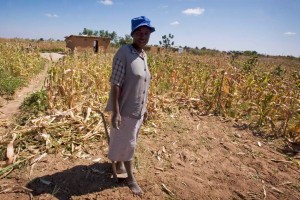
A woman stands outside her temporary home and dried up maize crop in Epworth, Harare, Zimbabwe. Photo: Kate Holt/IRIN
Key Messages
Crisis (IPC Phase 3) acute food insecurity outcomes are expected across most typical food-deficit parts of the country from February to May and will extend through September in some areas. These outcomes are mainly due to depleted own-produced food stocks, anticipated 2018-19 poor harvests, constrained livelihoods, and high food prices. Stressed (IPC Phase 2) outcomes are expected in high-production areas as poor households may meet their basic food needs but will be unable to meet their other livelihood needs.
A late start of season and below-average rains for the 2018-19 cropping season have resulted in below-normal cropped areas, significant rates of temporary and permanently wilted crop, and poor water and pasture conditions, especially in arid areas. Typical livelihood activities like casual labor have also been affected. The harvest time is likely to be delayed in most areas, starting in April compared to March. The 2018-19 crop production is expected at below-average levels across the country.
Economic hardships are expected to continue impacting livelihoods and the food security situation for poor and other household groups across the country. Foreign currency shortages, the parallel market, multiple-pricing systems and high and speculative pricing will likely continue during the Outlook period. The government has introduced new monetary policy measures aimed at addressing these challenges, though the effects and impacts of these measures are yet to be assessed.
Post published in: Agriculture

